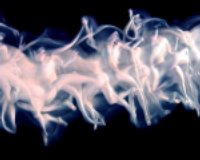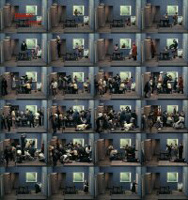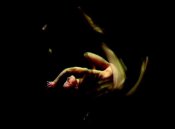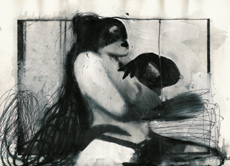Opening
Program  Installation Installation
 Program
1 Program
1  Program
2-3 Program
2-3  Program
4-5 Program
4-5  Program
6 Program
6  Program
7 Program
7  Program
8 Program
8  Program
9 Program
9  Program
10 Program
10  Program
11 Program
11  Program
12 Program
12  Program
13 Program
13  Program
14 Program
14  Closing
Ceremony Closing
Ceremony

Program
13: Film
as a Plastic Art: Canvas in Motion
Kwadrat
(5min, 1972, Poland)
Director: Zbigniew Rybchinsky
A human
figure is slowly generated from a white square, against a black
background, and is colored and decomposed in space, generating
in turn other squares, which reunite, retransforming themselves
into the original white square.
Zbig Rybczynski was
born in Poland in 1949 and has been working as a film director
in Europe and the United States since the early 1970s. His work
has received many prestigious industry awards in the United
States, Japan and Europe. The awards include an Academy Award
in 1983 for “Tango”, an Emmy in Special Effects
in 1990 for “The Orchestra”, the Prix Italia, the
Golden Gate Award in San Francisco and awards at the Electronic
Cinema Festival Tokyo/Montreaux. Numerous other awards include
MTV, American Video Awards, Monitor Awards and the Billboard
Music Video Awards. Zbig is a pioneer in using High Definition
television technology, and an innovator and experimentator in
the technical field - he's an author of several US patents,
which are mostly the innovative ideas for film and video making,
including "Zbig "software for matting. He currently
lives in Los Angeles, where he works for the Ultimatte Corporation
as a member of their R&D team www.ultimatte.com and runs
his own company, Zbig Vision Ltd.
Soma (4min,
2001, UK)
Director: Erica Russell
"Soma"
is film about the fragmentation of identity and body image in
the chaos of the post-modern urban culture. Presenting images
of dislocation and violence, the film is inspired by street
dance styles, graffiti art and the paintings of New York artist
Basquiat. It uses various styles of brush-painting.
Erica Russell
entered the animation industry as a paint-and-tracer and she
has worked on all aspects of animated film production. In all
her work Erica prefers to be the complete auteur, executing
every stage of the work herself. She has shown her work at numerous
festivals around the world, at the New York Metropolitan Museum
of Modern Art and the Tate Gallery, London. In '92 Erica set
up an independent production company with her partner and producer
Adam Parker-Rhodes, in her own home at Highgate in North London,
under the name Gingco. Her company has produced and contributed
to numerous music videos, TV title sequences and commercials,
for Europe and the US including three for FCB/SF’s Levi's
Jeans for Women series. One of these, “Sensual”,
which was based on Erica’s own designs and concept, won
a Cleo Award. She is currently working on a project to set up
an animation department and production studio at the University
of the West Indies, Trinidad.
“Nascent”
(10min, 2005, Australia)
Director: Gina Czarnecki
with Australian Dance Theatre and Christian Fennesz
Produced by Forma and Australian Dance Theatre
Commissioned by Forma and Adelaide Film Festival
"Nascent"
is a visual and visceral journey through and about being. A
film and installation, the piece's hybrid form exists between
visual art, experimental media, technology and dance.
 |
| photo
by Gina Czarnecki |
In “Nascent”,
raw footage of improvised and choreographed performance by ADT
dancers is confronted with compositional techniques applied
in the post-production stage. Images form a complex and dense
rhythmic structure, stretching, smearing and distorting ‘real’
time. The dancers' gestures and bodies, poised and isolated,
gradually become intertwined, indistinguishable and frenetic
- turbulent, mutated fragments that form and reform. A few frames
of internal body image blast in as subliminal interventions
or as momentary abstractions, leaving fleeting impressions of
parallel structures - organisms, mutant animals, ghosts, mechanical
insertions. The image processing creates new traces of movement
that appear as blips in transmission or digital ‘vibrations’
where the body and its image tune-in, momentarily, then become
‘unplugged’ leaving behind traces of skin-print
as after-images.
Ultimately the image remains recognisably human, but only just.
The score is specially commissioned music from Fennesz, whose
own computer manipulation and processing of 'analogue' source
sound echoes Czarnecki's approach to the treatment of image,
and in turn influenced the final edit of the piece. «Nascent»
was awarded Best Dance Film at the Australian Dance Awards,
2005.
Gina Czarnecki works
in time-based and digital media, making single-screen, photographic
and installation works. Through sampling, generating and re-processing
image and sound, she creates contemplative spaces with strong
visual aesthetics. Her work focuses on the human, the physical,
biological and psychological. More recently this has been concerned
with the ethical and cultural issues raised from scientific
and technological advances in the fields of genetic engineering,
as well as on their future commercial and non-commercial uses.
Her work has been exhibited internationally including ISEA 1998
in Liverpool and Ars Electronica ‘life sciences’
in Linz, Austria in1999. She won a prestigious Creative Scotland
Award in 2002 for work on her interactive installation Silvers
Alter, which was exhibited at the Natural History Museum, London
in summer 2003.
|
|
with
the support from FORMA |
Tango (8min,
1980, Poland) – Oscar winner 1983
Director: Zbigniew Rybchinsky
 |
| photo
by Zbigniew Rybchinsky |
A child enters
a room to get back his ball. Slowly, the entire space becomes
filled with bizarre characters, all of them intent on repeating
the same gesture ad infinitum.
"Thirty-six characters from different stages of life - representations
of different times - interact in one room, moving in loops, observed
by a static camera. I had to draw and paint about 16.000 cell-mattes,
and make several hundred thousand exposures on an optical printer.
It took a full seven months, sixteen hours per day, to make the
piece. The miracle is that the negative got through the process
with only minor damage, and I made less than one hundred mathematical
mistakes out of several hundred thousand possibilities…
“- ZR
Zbig Rybczynski (see above)
"Ma Mère l’Oye"
(30min, 2004, Belgium)
Director: Thierry De Mey
Choreographer: Anna Theresa De Keersmaeker
 |
| photo
by Thierry De May |
The orchestral
richness of this ballet by Maurice Ravel is conveyed in episodes
inspired by Charles Perrault’s famous fairy tales. The choreographic
material was produced by choreographer-dancers invited to choose
a character from the fairy tale and create a dance sequence in
the unusual setting of a forest. The illustrative or narrative
arguments are used in a very free way, more like poetical suggestions.
The plant world acts as an agent provocateur that helps inspire
an original quality of movement in front of the camera. The film
editing will use different formats: triptych, double screen, split
screens, full screen in order to link the dance sequences according
to the musical motifs and orchestral moods.
Thierry De Mey,
born in 1956, is a film director and composer. The incorporation
of movement and rebound are the common thread at the core of his
work: "the rebuttal of the idea of rhythm as a simple series
of durations in a time frame, but rather as a generative system
for impulses, falls and new developments” constitutes the
preliminary overture for his musical and cinematic endeavours.
For the choreographers Anne Teresa De Keersmaeker, Wim Vandekeybus
and his sister Michele Anne De Mey, Thierry continues to be an
invaluable collaborator in the invention of "formal strategies"
- to employ a term which holds great importance for him. The installations
of Thierry De Mey, which include music, dance, videos and interactive
processes, have been presented in exhibitions such as the Biennials
of Venice, Lyon and in many museums. His work has been rewarded
with many national and international prizes including the Bessie
Awards, Eve du Spectacle, Composers Forum of UNESCO to name a
few. He is currently working on the composition of an original
score for the project between the choreographer Akram Khan (London/India)
and Sylvie Guillem (Paris).
“Triangle”
(9min, 1994, UK) – Oscar nominated
Director: Erica Russell
"Triangle"
is a film where the passions of young lovers and another woman
are expressed through dance and paint. It makes powerful use
of music and artwork that range from classical drawing to pure
abstraction. Charlie Hart's soundtrack uses African and Brazilian
musicians and themes.
Erica Russell (see above).
“Infected”
(7min, 2001, Australia)
Director: Gina Czarnecki
“Infected”
is a film about the nature of the physical body in the context
of future technological possibilities, seen through dance and
digitally manipulated imagery. The new bio-engineered body is
still a sexual, stark, brutal, organic, pounding bloody system
with ripping tendons. It is beautiful and repulsive, indulgent,
curious, emotional, un/controlled, breeding, changing….
 |
| photo
by Gina Czarnecki |
“Infected”
begins in darkness; a small streak of light expands into a series
of more complex shapes, eventually revealing itself as the body
of a dancer. Confined within a circular projection screen the
dancer moves with the distracted, disorientated impatience of
a caged animal. As the film progresses, the image is manipulated
until flesh takes on an almost liquid appearance. The figure
stutters, jumps, blurs, is broken. We observe this image corruption
as if by electronic interference. The deformation of the image
is analogous to the descent of this once controlled body into
trauma. There is something of the tortured, hallucinatory figures
and distraught sexuality of Francis Bacon haunting this work,
destined to repeat its infection in perpetuity. Is this a futuristic
vision of the human body infiltrated and changed, 'infected'
by biotechnology, or is the reverse happening? Is the human
body, the warm-blooded body of sinews and emotions, corrupting
the "pure light" of technology?” - GC
Gina Czarnecki (see above).
"La
Piccola Russia" (17
min, 2004, Italy) – ("The Little Russian")
Dir: Gianluigi Toccafondo
 |
| photo
by Ginaluigi Toccafondo |
An Italian
short, winner of Best Narrative Short Film Under 35 Minutes at
the Ottawa Animation Film Festival 2004, “traces the life
of a young boy who grows up to be a murderer. Arguably Toccafondo’s
most narrative driven film, each image stands alone like a painting
or a photograph in a scrapbook. Greys, whites, and blacks distort
and swallow the photographed images in “La Picolla Russia”,
giving the film both a cloudy, dour ambiance while reflecting
the menace of doom and chaos that litters the protagonist’s
confused mind…
In summarizing his work, Gianluigi Toccafondo says, “Cinema
is my starting point. I make photos from film-clips; I xerox them
on paper and then paint on them, transforming the original subject.
Finally I make the shots with the 35mm film and they become cinema
again.” Like Dr. Frankenstein, Toccafondo takes scraps from
an old world and breathes new life into them.” – Ottawa
Animation Film Festival
Gianluigi Toccafondo
was born in San Marino, Italy. He attended the National Arts Institute
in Urbino to study hand-drawn animation. Besides his independent
animations, he produced numerous pieces for French Television
including a series of shorts – “Tunnel”, “Avanzi”,
“La pista del maiale” as well as a five-hour film
“Criminal” that was also presented at the Venice Biennale
in 1993. He has also worked on quite a few commercials including
the ones for Levi's and Sambuca Molinari. Since 1992, he has exhibited
his drawining in many galleries in Italy and abroad. At the same
time, his drawings became part of editions released by Fandango,
Einaudi, Feltrinelli, Mondadori and other publishers. Gianluigi
currently lives in Italy.
 |
with
the support from the TTV Festival |
|
|

